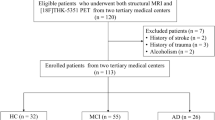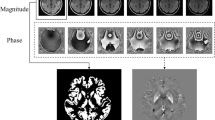Abstract.
Purpose
The aim of this study was to compare the diagnostic performance of 18F-fluorodeoxyglucose (FDG) positron emission tomography (PET) and voxel-based morphometry (VBM) on magnetic resonance imaging (MRI) in the same group of patients with very mild Alzheimer’s disease (AD).
Methods
Thirty patients with very mild AD (age 67.0±5.8 years; MMSE score 25.5±1.2, range 24–28), 32 patients with mild AD (age 67.0±4.5 years, MMSE score 22.1±0.8, range 21–23) and 60 age- and sex-matched normal volunteers underwent both FDG-PET and three-dimensional spoiled gradient echo MRI. Statistical parametric mapping was used to conduct voxel by voxel analysis and Z score mapping. First, the region of interest (ROI) maps of significant reductions in glucose metabolism and grey matter density in the mild AD patients were defined. Secondly, analysis of receiver operating characteristic (ROC) curves for Z scores in the ROI maps discriminating very mild AD patients and normal controls was performed.
Results
In mild AD patients, FDG-PET indicated significant reductions in glucose metabolism in the bilateral posterior cingulate gyri and the right parietotemporal area, while VBM analysis showed a significant decrease in grey matter volume density in the bilateral amygdala/hippocampus complex, compared with the normal control group. ROC analysis showed that in very mild AD patients the accuracy of FDG-PET diagnosis was 89% and that of VBM-MRI diagnosis was 83%. The accuracy of the combination of FDG-PET and VBM-MRI diagnosis was 94%.
Conclusion
In very mild AD, both FDG-PET and VBM-MRI had high accuracy for diagnosis, but FDG-PET showed slightly higher accuracy than VBM-MRI. Combination of the two techniques will yield a higher diagnostic accuracy in very mild AD by making full use of functional and morphological images.







Similar content being viewed by others
References
Grundman M, Sencakova D, Jack CR Jr, Petersen RC, Kim HT, Schultz A, et al. Alzheimer’s Disease Cooperative Study. Brain MRI hippocampal volume and prediction of clinical status in a mild cognitive impairment trial. J Mol Neurosci 2002;19:23–27
Karas GB, Scheltens P, Rombouts SA, Visser PJ, van Schijndel RA, Fox NC, et al. Global and local gray matter loss in mild cognitive impairment and Alzheimer’s disease. Neuroimage 2004;23:708–716
de Leon MJ, DeSanti S, Zinkowski R, Mehta PD, Pratico D, Segal S, et al. MRI and CSF studies in the early diagnosis of Alzheimer’s disease. J Intern Med 2004;256:205–223
de Toledo-Morrell L, Stoub TR, Bulgakova M, Wilson RS, Bennett DA, Leurgans S, et al. MRI-derived entorhinal volume is a good predictor of conversion from MCI to AD. Neurobiol Aging 2004;25:1197–1203
Minoshima S, Giordani B, Berent S, Frey KA, Foster NL, Kuhl DE. Metabolic reduction in the posterior cingulate cortex in very early Alzheimer’s disease. Ann Neurol 1997;42:85–94
Mosconi L. Brain glucose metabolism in the early and specific diagnosis of Alzheimer’s disease. FDG-PET studies in MCI and AD. Eur J Nucl Med Mol Imaging 2005;32:486–510
Mosconi L, Perani D, Sorbi S, Herholz K, Nacmias B, Holthoff V, et al. MCI conversion to dementia and the APOE genotype: a prediction study with FDG-PET. Neurology 2004;63:2332–2340
Herholz K. PET studies in dementia.Ann Nucl Med 2003;17:79–89
Ashburner J, Friston KJ. Voxel-based morphometry—the methods. Neuroimage 2000;11:805–821
Baron JC, Chetelat G, Desgranges B, Perchey G, Landeau B, de la Sayette V, et al. In vivo mapping of gray matter loss with voxel-based morphometry in mild Alzheimer’s disease. Neuroimage 2001;14:298–309
Burton EJ, Karas G, Paling SM, Barber R, Williams ED, Ballard CG, et al. Patterns of cerebral atrophy in dementia with Lewy bodies using voxel-based morphometry. Neuroimage 2002;17:618–630
Ishii K, Kawachi T, Sasaki H, Kono AK, Fukuda T, Kojima Y, et al. Voxel-based morphometric comparison between early- and late-onset mild Alzheimer’s disease and assessment of diagnostic performance of Z score images. AJNR Am J Neuroradiol 2005;25:333–340
Ishii K, Sasaki H, Kono AK, Miyamoto N, Fukuda T, Mori E. Comparison of gray matter and metabolic reduction in mild Alzheimer’s disease using FDG-PET and voxel-based morphometric MR studies. Eur J Nucl Med Mol Imaging 2005;32:959–963
McKhann G, Drachman D, Folstein M, Katzman R, Price D, Stadlan EM. Clinical diagnosis of Alzheimer’s disease: report of the NINCDS-ADRDA Work Group under the auspices of Department of Health and Human Services Task Force on Alzheimer’s disease. Neurology 1984;34:939–944
Folstein MF, Folstein SE, McHugh PR. “Mini-mental state”. A practical method for grading the cognitive state of patients for the clinician. J Psychiat Res 1975;12:189–198
Honma A, Fukuzawa K, Tsukada Y, Ishii T, Hasegawa K, Mohs RC. Development of a Japanese version of Alzheimer’s Disease Assessment Scale (ADAS). Jpn J Geriatr Psychiatry 1992;647–655
Ishii K, Sasaki M, Kitagaki H, Yamaji S, Sakamoto S, Matsuda K, et al. Reduction of cerebellar glucose metabolism in advanced Alzheimer’s disease. J Nucl Med 1997;38:925–928
Friston KJ, Ashburner J, Frith CD, Poline J-B, Heather JD, Frackowiak RSJ. Spatial registration and normalization of images. Human Brain Mapping 1995;3:165–189
Ashburner J, Neelin P, Collins DL, Evans AC, Friston KJ. Incorporating prior knowledge into image registration. Neuroimage 1997;6:344–352
Ashburner J, Friston KJ. Nonlinear spatial normalization using basis functions. Human Brain Mapping 1999;7:254–266
Ishii K, Sasaki M, Matsui M, Sakamoto S, Yamaji S, Hayashi N, et al. A diagnostic method for suspected Alzheimer’s disease using H2 15O positron emission tomography perfusion Z score. Neuroradiology 2000;42:787–794
Bookstein FL. “Voxel-based morphometry” should not be used with imperfectly registered images. Neuroimage 2001;14:1454–1462
Ashburner J, Friston KJ. Why voxel-based morphometry should be used. Neuroimage 2001;14:1238–1243
Kesslak JP, Nalcioglu O, Cotman CW. Quantification of magnetic resonance scans for hippocampal atrophy in Alzheimer’s disease. Neurology 1991;41:51–54
Scheltens P, Leys D, Barkhof F, Huglo D, Weinstein HC, Vermersch P, et al. Atrophy of medial temporal lobes on MRI in “probable” Alzheimer’s disease and normal ageing: diagnostic value and neuropsychological correlates. J Neurol Neurosurg Psychiatry 1992;55:967–972
Jack CR, Petersen RC, O’Brien PC, Tangalos EG. MR-based hippocampal volumetry in the diagnosis of Alzheimer’s disease. Neurology 1992;42:183–188
Watson C, Andermann F, Gloor P, Jones-Gotman M, Peters T, Evans A, et al. Anatomic basis of amygdaloid and hippocampal volume measurement by magnetic resonance imaging. Neurology 1992;42:1743–1750
de Leon MJ, Golomb J, George AE, Convit A, Tarshish CY, McRae T, et al. The radiologic prediction of Alzheimer’s disease: the atrophic hippocampal formation. AJNR 1993;14:897–906
Kiliany RJ, Moss MB, Albert MS, Sandor T, Tieman J, Jolesz F. Temporal lobe regions on magnetic resonance imaging identify patients with early Alzheimer’s disease. Arch Neurol 1993;50:949–954
Lehéricy S, Baulac M, Chiras J, Pierot L, Martin N, Pillon B, et al. Amygdalohippocampal MR volume measurements in the early stages of Alzheimer’s disease. AJNR 1994;15:927–937
Chetelat G, Desgranges B, De La Sayette V, Viader F, Eustache F, Baron JC. Mapping gray matter loss with voxel-based morphometry in mild cognitive impairment. Neuroreport 2002;13:1939–19343
Mosconi L, Tsui WH, De Santi S, Li J, Rusinek H, Convit A, et al. Reduced hippocampal metabolism in MCI and AD: automated FDG-PET image analysis. Neurology 2005;64:1860–1867
Burdette JH, Minoshima S, Vander Borght T, Tran DD, Kuhl DE. Alzheimer disease: improved visual interpretation of PET images by using three-dimensional stereotaxic surface projections. Radiology 1996;198:837–843
Ishii K, Sasaki M, Yamaji S, Sakamoto S, Kitagaki H, Mori E. Demonstration of decreased posterior cingulate perfusion in mild Alzheimer’s disease by means of H2 15O positron emission tomography. Eur J Nucl Med 1997;24:670–673
Ishii K. Clinical application of positron emission tomography for diagnosis of dementia. Ann Nucl Med 2002;16:515–525
Bartenstein P, Minoshima S, Hirsch C, Buch K, Willoch F, Mosch D, et al. Quantitative assessment of cerebral blood flow in patients with Alzheimer’s disease by SPECT. J Nucl Med 1997;38:1095–1101
Kanetaka H, Matsuda H, Asada T, Ohnishi T, Yamashita F, Imabayashi E, et al. Effects of partial volume correction on discrimination between very early Alzheimer’s dementia and controls using brain perfusion SPECT. Eur J Nucl Med Mol Imaging 2004;31:975–980
Ishii K, Sakamoto S, Sasaki M, Kitagaki H, Yamaji S, Hashimoto M, et al. Cerebral glucose metabolism in patients with frontotemporal dementia. J Nucl Med 1998;39:1875–1878
Ishii K, Imamura T, Sasaki M, Yamaji S, Sakamoto S, Kitagaki H, et al. Regional cerebral glucose metabolism in dementia with Lewy bodies and Alzheimer’s disease. Neurology 1998;51:125–130
Hirono N, Mori E, Ishii K, Ikejiri Y, Imamura T, Shimomura T, et al. Frontal lobe hypometabolism and depression in Alzheimer’s disease. Neurology 1998;50:380–383
Hirono N, Mori E, Ishii K, Ikejiri Y, Imamura T, Shimomura T, et al. Regional hypometabolism related to language disturbance in Alzheimer’s disease. Dement Geriatr Cogn Disord 1998;9:68–73
Hirono N, Mori E, Ishii K, Kitagaki H, Sasaki M, Ikejiri Y, et al. Alteration of regional cerebral glucose utilization with delusions in Alzheimer’s disease. J Neuropsychiat Clin Neurosci 1998;10:433–439
Author information
Authors and Affiliations
Corresponding author
Rights and permissions
About this article
Cite this article
Kawachi, T., Ishii, K., Sakamoto, S. et al. Comparison of the diagnostic performance of FDG-PET and VBM-MRI in very mild Alzheimer’s disease. Eur J Nucl Med Mol Imaging 33, 801–809 (2006). https://doi.org/10.1007/s00259-005-0050-x
Received:
Accepted:
Published:
Issue Date:
DOI: https://doi.org/10.1007/s00259-005-0050-x




